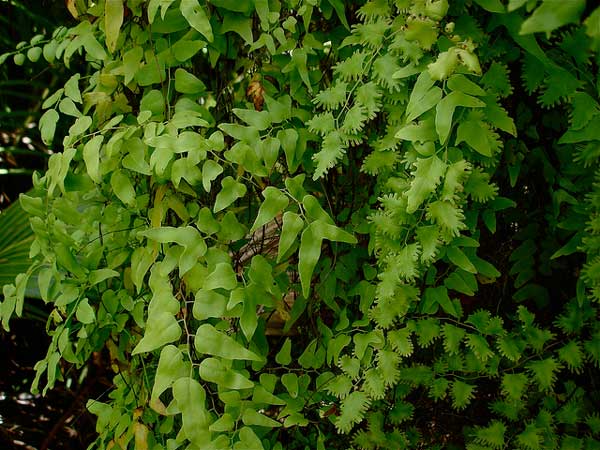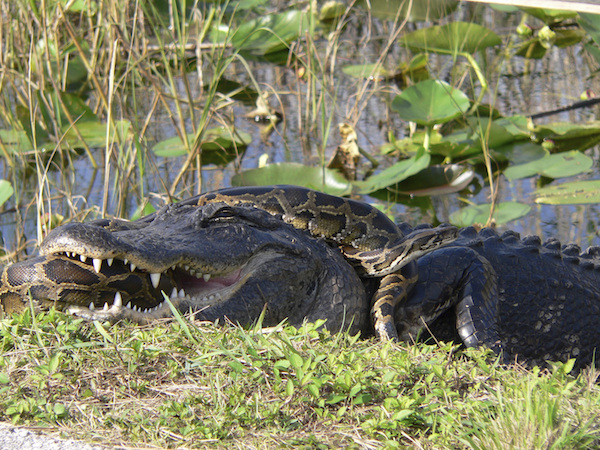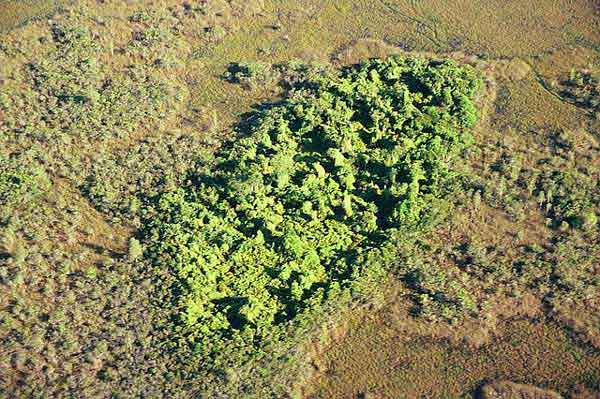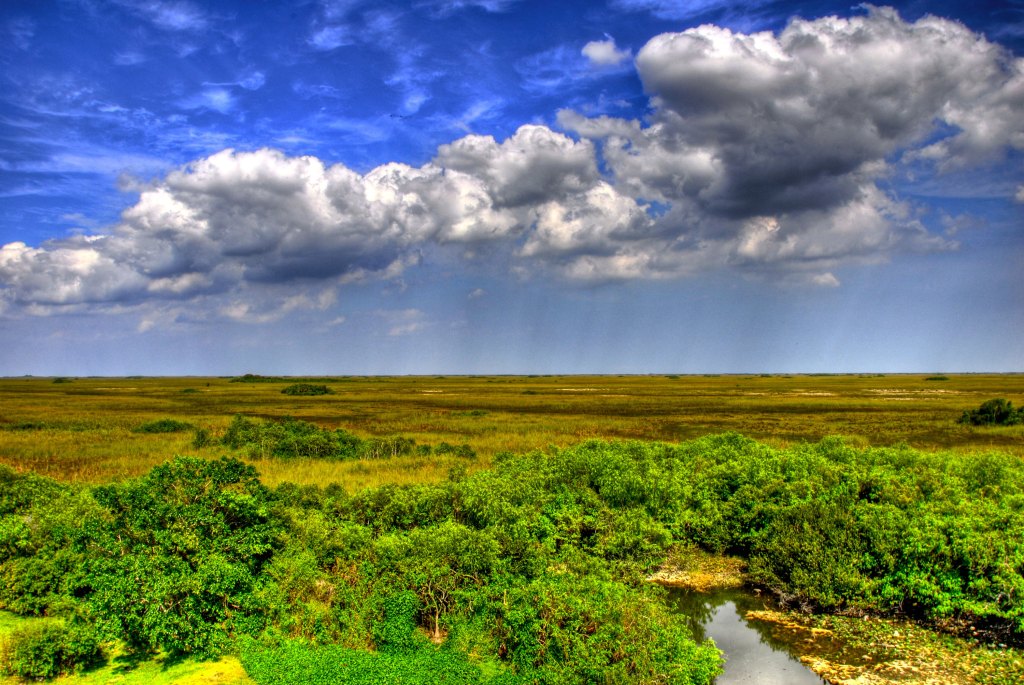A deceptively deadly force is slithering its way through the Florida Everglades. Sinuous and stealthy, this invasive species is one of the greatest threats to the ecosystem. And it’s not a python.
Old World climbing fern, Lygodium microphyllum, is arguably the worst of many invasive species in the Everglades.
“It grows quickly, spreads easily, and is changing the entire ecosystem,” says Kristina Serbesoff-King, the associate director of conservation for the Conservancy’s Florida chapter.
Pythons may get all the press, but this little fern has some serious destructive potential.
What is So Bad About a Fern?
Native to Africa, Australia, and southeast Asia, Old World climbing fern (OWCF) was introduced to Florida as an ornamental garden plant and was first found in the wild in the 1960s.
This situation is typical of non-native species — 90 percent of the problem invasive plants Florida were brought in on purpose, says Serbesoff-King, typically as ornamental or forage plants. Pythons were intentionally brought to the state, too, and today’s wild population is descended from both escaped and purposefully released pets.
But OWCF isn’t you’re average garden plant — it’s a highly invasive, insidious fern that’s adaptable, fast-growing, difficult to control, excellent at colonizing remote areas, and hard to kill. As far as invasives go, it’s a quadruple-whammy.
OWCF’s destructive power lies in sheer mass — it slinks its way up, over, and around native plants. Eventually the fern completely covers their leaves, blocking sunlight and literally smothering them. Native plant and animal species decline, and the fern takes over.

Plant vs. Python
South Florida has no shortage of invasive species — according to estimates from the South Florida Water Management District, more than 130 of the animals in the greater Everglades ecosystem are non-natives, and about 26 percent of the mammals, birds, reptiles, amphibians, and fish in all of South Florida are non-native.
Pythons are certainly among the worst — they’re devouring mammals, birds, and bird eggs at destructive rates, having a direct impact on Everglades wildlife. So how can a plant be as problematic as a python?
The Everglades ecosystem is the emblematic river of grass, dotted with hardwood tree islands, or hammocks. Hammocks are a critical habitat for Everglades animals, providing dry ground, refuge, and a place to find food and breed.
But hammocks are no match for OWCF, which buries the islands under so much plant matter that they literally collapse. “They look like a massive green crater,” says Serbesoff-King, “because the outside rim of trees is still standing, but middle has collapsed in on itself.”
OWCF also makes tree islands vulnerable to fire, says LeRoy Rodgers, a lead scientist with the South Florida Water Management District. The fern’s tendrils act like a bridge, transporting fire from the marsh grasses onto the islands.
“The fern is literally changing the landscape and the processes that make this habitat unique,” he says.

Restoration in Peril
If changing the very ecosystem wasn’t bad enough, OWCF may also jeopardize Everglades restoration efforts.
Rodgers explains that OWCF is not widespread across the Everglades ecosystem — yet. Most of the infestation is concentrated in Loxahatchee National Wildlife Refuge, where good management spared many of the tree islands from destruction.
Restoration efforts are expected to increase the number of tree islands, which just so happen to be the fern’s favorite habitat. “The better we make the habitat, the more likely it is to be invaded by the fern,” says Rodgers.
He worries that OWCF could thwart billion-dollar restoration efforts to fix the historic flow of water across the state to the Everglades. “Even if we fix the water,” he says “it’s not going to be the Everglades anymore if we don’t remove plants like melaleuca and climbing fern.”

Fighting Back
For melaleuca — the poster-child of invasive species in south Florida — machetes and poison are the tools of the trade. But manual removal can actually make an OWCF infestation worse, says Serbesoff-King. The slightest yank to a vine sends millions of minuscule spores billowing into the air — and onto the clothes, vehicles, and tools of the people trying to remove it.
“Some people try to pull up the fern, load it into truck beds, and drive it off their property,” she says. “The next year, the entire roadway they drove past is covered in the fern.”
Herbicides are the best weapon, but mass application isn’t an option because OWCF fern grows on plants, and a heavy hand will end up killing native plants, too. And it takes more than one treatment to finish the job.
“When you treat an invasive plant the first year, all you do is make it angry,” says Serbesoff-King. “The plant’s reaction is to release as many seeds or spores as possible because it knows it’s dying.”
But land managers have one final weapon. Like other invasive species, OWCF has few or no predators, parasites, or pathogens, so there’s little to stop it from spreading — unless you import a fern nemesis from its native range.
This tactic, known as biological control, has proved successful in controlling other species, including melaleuca. Between 2004 and 2009, the U.S. Department of Agriculture introduced two species of lygodium moth and one species of lygodium gall mite, all of which harm the fern by either feeding on its leaves or causing leaf deformities. So far, only one of the moth species is prospering in the wild.
Front Line of the Fern Fight
An invisible line runs across the Florida peninsula, from northern Tampa, through Ocala National Forest, and to Daytona Beach. It’s the northward range of OWCF, and the Conservancy and other partners are doing everything they can to hold the front line.
Cheryl Millett, a biologist with the Florida chapter, helps run a monitoring and treatment network called the Central Florida Lygodium Strategy. Using a combination of aerial surveys and boots-on-the-ground monitoring, Millet and her partners in the local, state, and federal government monitor a network of 130 sites along the invisible boundary.
Anytime the fern pops, up they coordinate rapid herbicide treatments to prevent further spread. The Conservancy also treats infestations on private lands, where the fern might otherwise go unnoticed.
“We are holding the line,” says Millett, “while we wait for the biological controls to help us out.”
Aside from manning the boundaries, the Conservancy is also looking ahead. Using existing invasive plants as an example, Doria Gordon, the Florida chapter’s director of conservation, and her colleagues at the University of Florida tested a Weed Risk Assessment for the state to identify whether it would accurately predict if a non-native plant species will turn into an all-out menace.
“With Old World climbing fern, we realized that we could have predicted its spread,” says Gordon. “We’re learning from this lesson and working preventatively to identify the next big invader.”
And in Florida, the “next big invader” is never far away.




Beautiful write up. We have a similar ecosystem in. Nigeria. How ever, it’s not invasive species that is threatening the forested islands but anthropogenic effects of oil exploration and production. Saline intrusion, flooding and hydrocarbon pollution are the major threats to the rain forest islands within the Mangrove swamps in the Niger Delta. It’s important that more people know and support every effort made to preserve these unique ecosystems. They are vital for the survival of the communities living on or around these islands.
I need researchers who can collaborate or join my research team ‘CERG’… Coastal ecosystem research group based at the University of Benin, Benin City, Nigeria. Kudos
We have to safe them!I will not sit around while animals and the everglades die. We should take a stand and never back down until the animals and the everglades are safe! PLEASE HELP THE EVERGLADES!
???
Such an important topic. Invasives are literally changing the face of the biosphere before our lifetime, but we spend so much time chasing climate change that may or may not have a significant impact in 100 years.
Is it edible/useful? Does it serve a putpose… Im asking futuristically. Maybe a biofuel can be manufactured of OWCF. Maybe nature knows what it needs. I’d much rather have to eat fern while obtaining hydration as the fern depletes standinding water from mosquito breeding grounds.
It sound like you pour money and more money and do not attack the source. Not counting all the labor where you could use where it would really make a difference. Ask the American people to stop building and bringing in non native plants into the state of Florida. Now you know that is not going to happen because 90% of the Florida people do not care about the wild areas. They would rather see the everglades drained and built on with shopping centers, homes, etc. So why kid our self, just build in the everglades and hire lawn care.
Invasives continue to be a growing problem in the Everglades and just about everywhere else in the U.S. Despite this the government refuses to step up to the plate and ban the sale of hundreds of ornamental plants that are invasive and destructive to ecosystems. Most people have no idea how much invasives impact the environment or the economy. Unfortunately the same non-native ornamental plants are being sold and pushed which in turn is creating biological deserts in highly developed areas.
We really should do something about architect and landscape communication. Every bad view, annoying neighbor, and overheated situation is something people will change for the least amount of money which is an invitation to all invasives. Correct autocad and save the environment, municipal budgets and so much more. Require it to have plant unit checks because they don’t grow in metrics or standard units, by law. DO Not Leave Necessity Lying Around!
Don’t forget the African Snails
Sounds like the degree of problem we faced at Midway with the Verbesina infestation. Pulling the plant just spread it. Herbicides are the way to go but getting the formula and timing right is the key.
don’t leave out the air potato